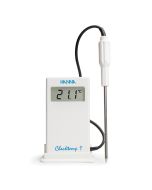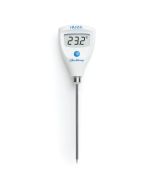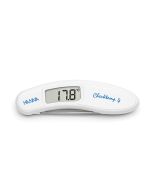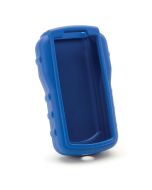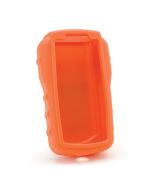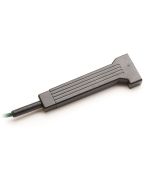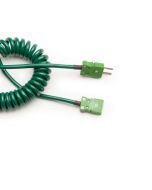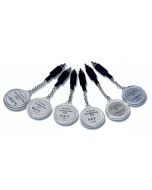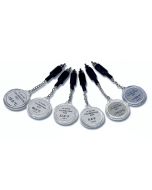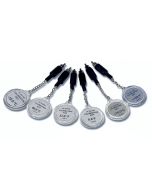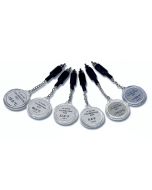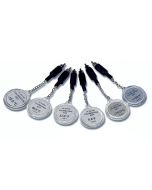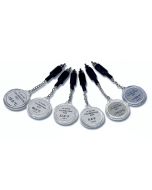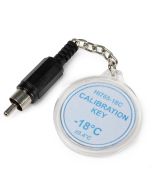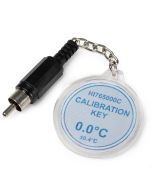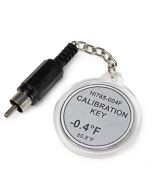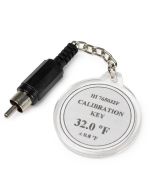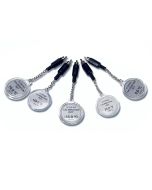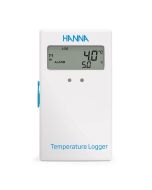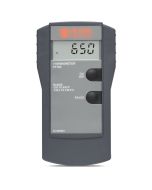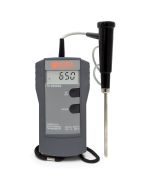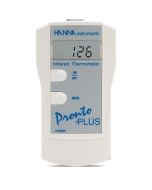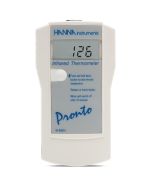Temperature

Precise process control is an important factor to maintaining high production quality, just as precision and accuracy are the key to research. Temperature is a crucial variable in both production and research.
Glass and metal thermometers use the physical law of thermal expansion to measure temperature. However, this method has limitations in accuracy and range. Glass construction is fragile and comes with risk to a person’s health, as well as to the environment. For these reasons, an alternative way of measuring temperature has become necessary. Hanna electronic thermometers are designed to withstand mechanical stress and extreme environments while maintaining high accuracy.
Electronic thermometers provide the versatility, speed and accuracy requested by operators in all areas of temperature measurement. Speed is important when the reactions being monitored change rapidly. Small, compact sensors are preferable for tightly arranged areas, such as electronics and other miniature applications. Electronic thermometers allow users to monitor maximum, minimum and even average temperatures.
Dedicated research teams, precision process control, integrated production facilities, and an overall team effort is required to meet the demanding applications of our users. Hanna’s extensive professional thermometer line constitutes the true dedication Hanna commits to thermometer design and production.
Achieving Thermometer Accuracy
Even though it is easy to show resolutions of 0.1 °C with digital thermometers, there is no relationship between resolution and accuracy of measurements. Below is a list of the main causes that can impact accuracy of temperature measurements:
- Instrument: The instrument may have an extended scale and 19,000 points of measurement may be obtained. Within these 19,000 points, the instrument may perform differently because of internal linearity.
- Electronic components: The internal electronics have a drift that depends on the ambient temperature. For this reason, the accuracy of the instrument is stated at a specific temperature of 20 or 25°C, and the drift has to be specified for each degree of variation with respect to the reference temperature.
- LCD: Liquid crystals have an operating limitation which is a function of temperature. Their normal range is between 0 and 50°C, but there are components capable of performing between -20 and 70°C.
- Batteries: Instrument battery power supply also has limitations of use.
- Temperature sensor: This is a separate accuracy, which is to be added to the instrument’s error.
With all the possible forces influencing accuracy, calibration verification is essential. Hanna’s thermometers with CAL Check™ can verify an accurate calibration quickly and easily.
Importance of Accuracy
Up to a few years ago, accuracy was not a very critical aspect and tolerances of a few degrees did not jeopardize a process. From the time that hazard analysis and critical control points (HACCP) programs became a necessity in the food industry, measurement accuracy has become a discriminating factor. Due to health risk factors, now an error of a few tenths of a degree can decide whether food can still be kept or must be discarded. In 1990, Hanna began to produce thermometers for our customers’ HACCP programs to comply with new governmental regulations. Soon after, Hanna became the market leader in Europe as a result of the technological solutions offered to our users.
Hanna CAL Check™ Calibration Feature
As previously described, the electronic components of an instrument shift with time. Hanna has made it possible for users, with the simple touch of a button, to verify whether the response of the instrument is within the tolerance limit of ±0.02oC.
The CAL Check system acts by substituting the sensor with an internal resistor which corresponds to 0oC; thus simulates the response that the temperature probe would have at 0oC.
Hanna thermometers can be divided into four main technologies: thermistor, thermocouple, Pt100, and infrared.
Testers
A variety of thermistor based testers are available. They include versions with a folding probe, reinforced handle for insertion into semi-solids, and ones that can mount on a refrigerator.
Accessories
Accessories include the calibration keys used with thermistor thermometers and shockproof rubber boots to add additional protection to the meters. Also include are the handles and extension cables used with probes that do not have a handle.
Dataloggers
Multiple temperature data loggers are available. These include versions with built-in and external thermistor probes.
Thermistor
The thermistor is a semi-conductor device whose resistivity (r) varies as a function of temperature (T):
- R = Ro [1 + a (T-To)] where,
- R = resistance of temp. at T
- T = temp at the end of measurement
- Ro = resistance of temp. at To
- To = temp at the beginning of measurement
Temperature resistance coefficient is the parameter that determines if the resistivity variation is positive (as with the Positive Temperature Coefficient, or PTC sensors) or negative (as with the Negative Temperature Coefficient, or NTC thermistors). It is possible to determine the temperature by applying a potential difference and measuring the resistance.
Thermistor sensors are suitable for a temperature range of -50 to 150oC (-58 to 302oF). Higher temperatures may damage the semi-conductor sensor. Accurate temperature measurements are possible (tenths of degree) due to the high sensitivity of the sensor.
Thermocouple
The thermocouple consists of the junction of two wires of different metals. At a given temperature, a potential difference results at the opposite extremes of the two wires (Seebeck effect), with the respective variations linearly related within small intervals. It is therefore possible to determine the temperature given the potential difference and characteristics of the two metals. The measurement end of the thermocouple probe is called the hot junction, while the connection of the thermocouple to the meter is the cold junction. An error is introduced as the cold junction is exposed to the ambient temperature. This error can be eliminated by physically putting the cold junction into an ice bath and forcing a reference temperature of 0oC, or by electronically compensating for the cold junction temperature effect. There are various types of thermocouples, identified by an ANSI code using a letter of the alphabet. The K type is the most commonly used thermocouple.
Probes
Available are K-type, T-type, thermistor and pt100 temperature probes. These probes include many different styles from penetration, liquids, air/gas, and wire probes.
